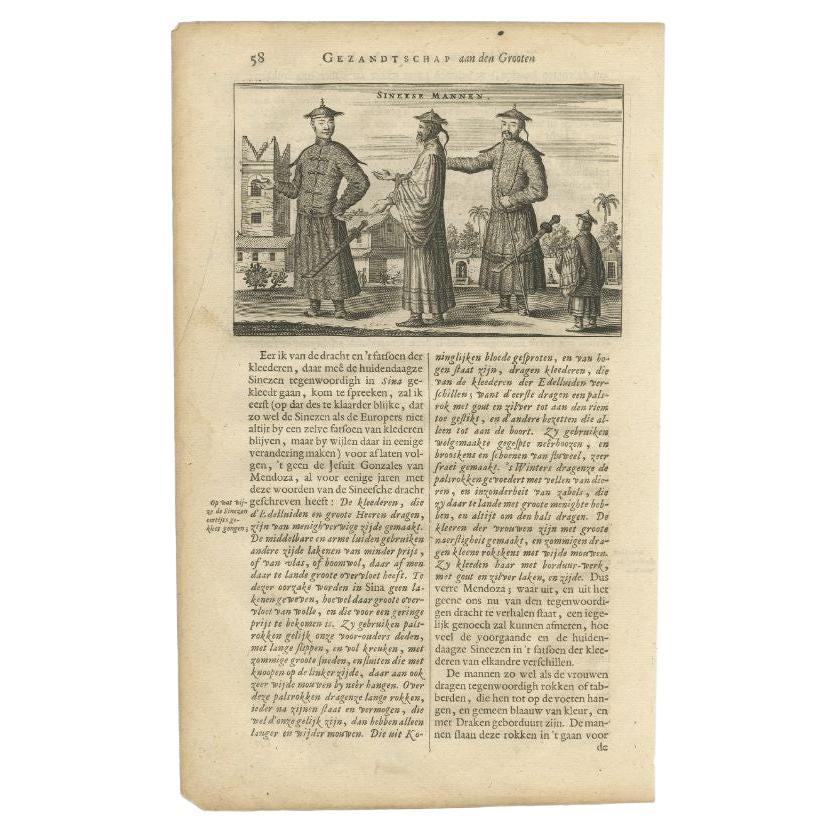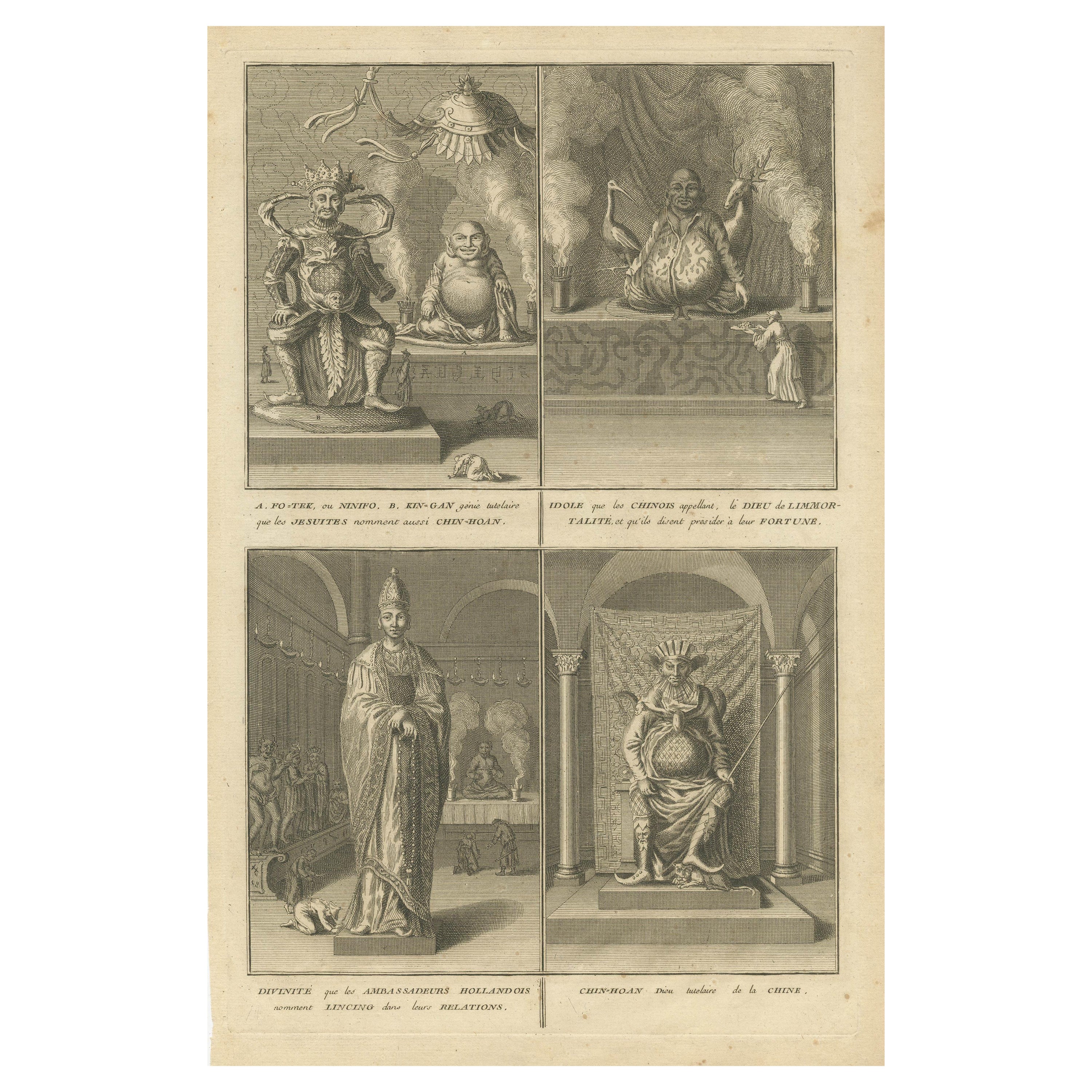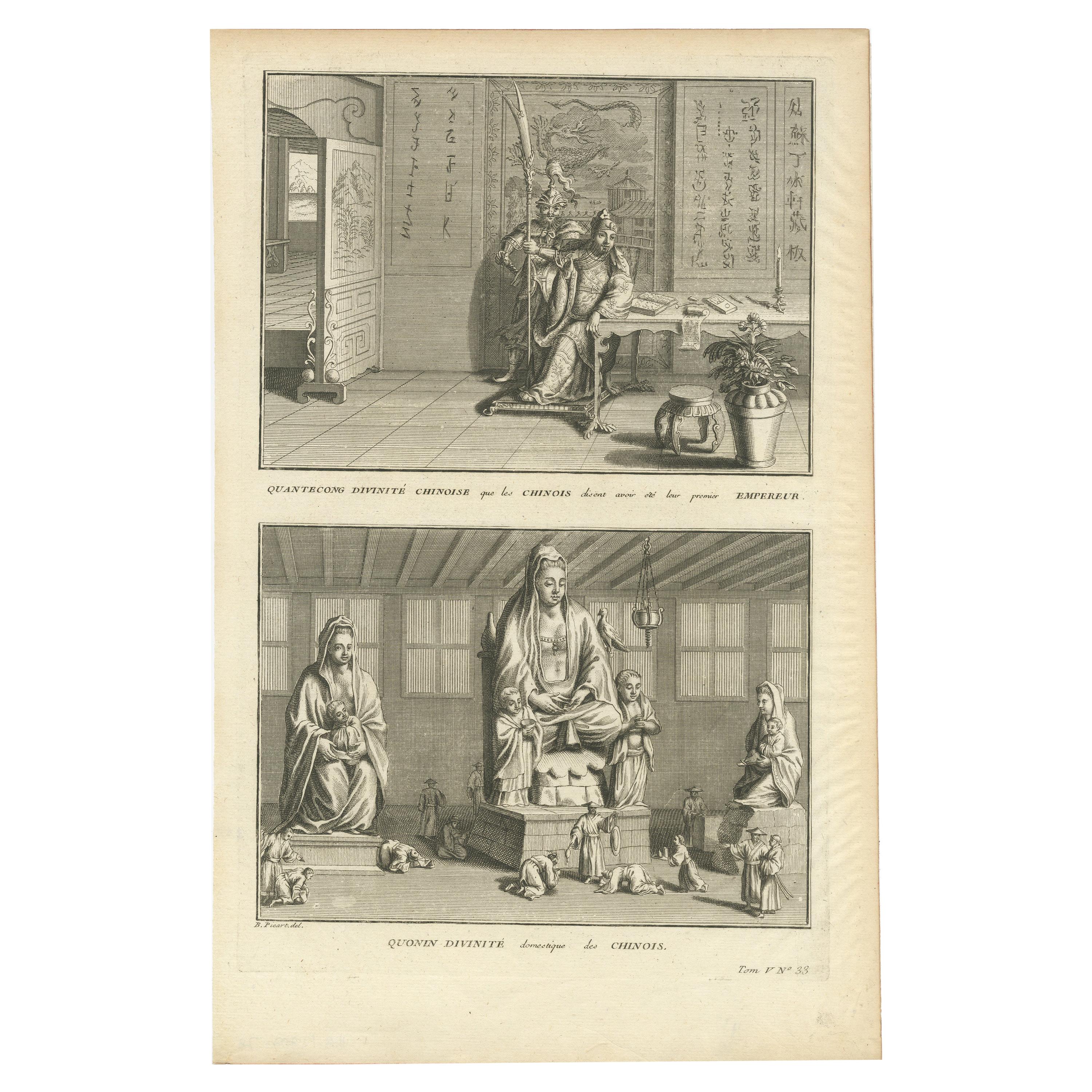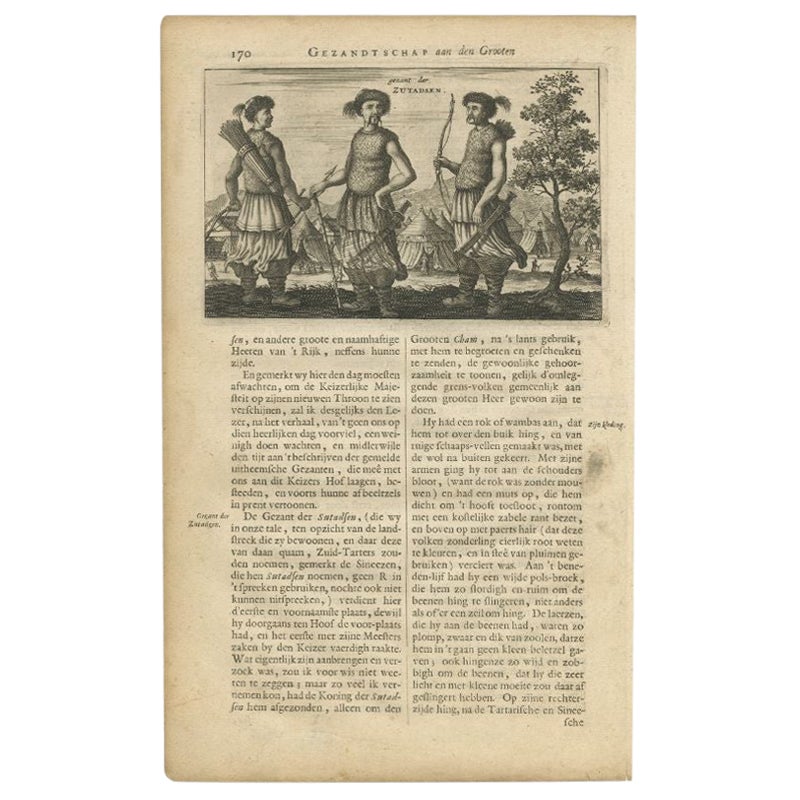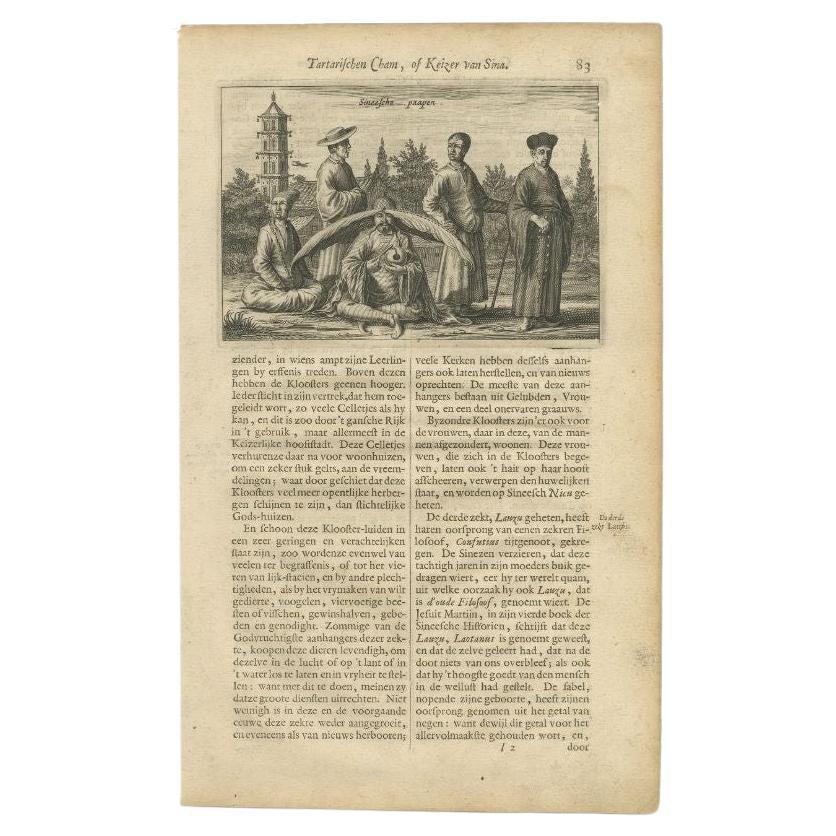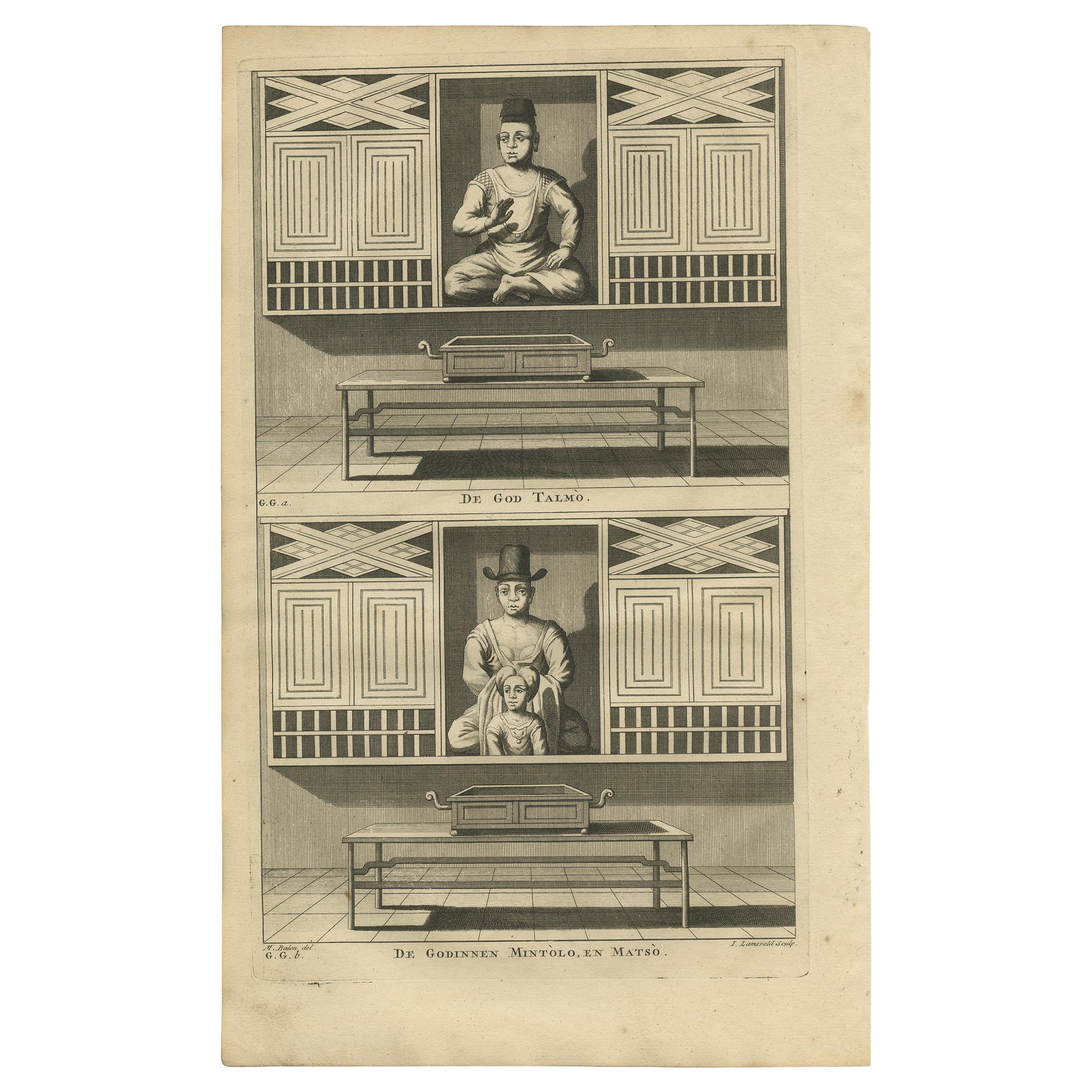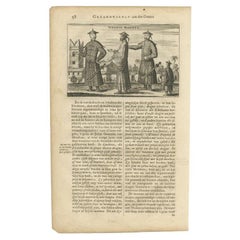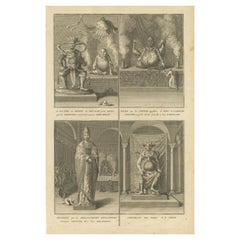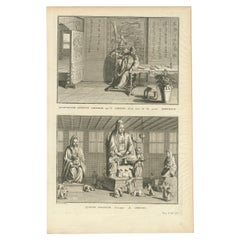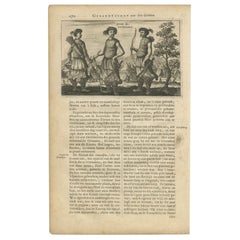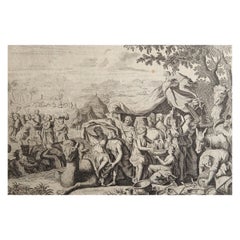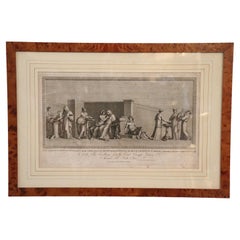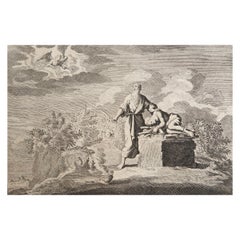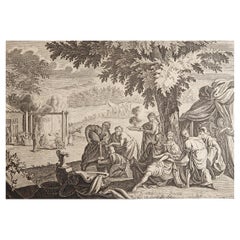Items Similar to Antique Print of Chinese Deities, 1665
Want more images or videos?
Request additional images or videos from the seller
1 of 6
Antique Print of Chinese Deities, 1665
$124.90
$156.1320% Off
£91.99
£114.9920% Off
€104
€13020% Off
CA$169.92
CA$212.4020% Off
A$188.82
A$236.0220% Off
CHF 98.94
CHF 123.6820% Off
MX$2,315.53
MX$2,894.4120% Off
NOK 1,261.96
NOK 1,577.4520% Off
SEK 1,187.21
SEK 1,484.0120% Off
DKK 791.74
DKK 989.6720% Off
Shipping
Retrieving quote...The 1stDibs Promise:
Authenticity Guarantee,
Money-Back Guarantee,
24-Hour Cancellation
About the Item
Antique print titled 'Kingang'. Old print depicting Chinese Deities / Idols, the Deity of immortality and the Deity of lust. Also depicted is a Chinese governor made into a deity. This print originates from 'Het gezantschap der Neêrlandtsche Oost-Indische Compagnie, aan den grooten Tartarischen Cham (..)' by J. Nieuhof.
Artists and Engravers: Published by J. van Meurs, Amsterdam.
Condition: Very good, general age-related toning. Dutch text on verso. Please study image carefully.
Date: 1665
Overall size: 19 x 30.5 cm.
Image size: 15 x 10 cm.
We sell original antique maps to collectors, historians, educators and interior decorators all over the world. Our collection includes a wide range of authentic antique maps from the 16th to the 20th centuries. Buying and collecting antique maps is a tradition that goes back hundreds of years. Antique maps have proved a richly rewarding investment over the past decade, thanks to a growing appreciation of their unique historical appeal. Today the decorative qualities of antique maps are widely recognized by interior designers who appreciate their beauty and design flexibility. Depending on the individual map, presentation, and context, a rare or antique map can be modern, traditional, abstract, figurative, serious or whimsical. We offer a wide range of authentic antique maps for any budget.
- Dimensions:Height: 12.01 in (30.5 cm)Width: 7.49 in (19 cm)Depth: 0 in (0.01 mm)
- Materials and Techniques:
- Period:
- Date of Manufacture:1665
- Condition:Condition: Very good, general age-related toning. Dutch text on verso. Please study image carefully.
- Seller Location:Langweer, NL
- Reference Number:Seller: BGI-002721stDibs: LU3054329370092
About the Seller
5.0
Recognized Seller
These prestigious sellers are industry leaders and represent the highest echelon for item quality and design.
Platinum Seller
Premium sellers with a 4.7+ rating and 24-hour response times
Established in 2009
1stDibs seller since 2017
2,494 sales on 1stDibs
Typical response time: 1 hour
- ShippingRetrieving quote...Shipping from: Langweer, Netherlands
- Return Policy
Authenticity Guarantee
In the unlikely event there’s an issue with an item’s authenticity, contact us within 1 year for a full refund. DetailsMoney-Back Guarantee
If your item is not as described, is damaged in transit, or does not arrive, contact us within 7 days for a full refund. Details24-Hour Cancellation
You have a 24-hour grace period in which to reconsider your purchase, with no questions asked.Vetted Professional Sellers
Our world-class sellers must adhere to strict standards for service and quality, maintaining the integrity of our listings.Price-Match Guarantee
If you find that a seller listed the same item for a lower price elsewhere, we’ll match it.Trusted Global Delivery
Our best-in-class carrier network provides specialized shipping options worldwide, including custom delivery.More From This Seller
View AllAntique Print of Chinese Men by Nieuhof, 1665
Located in Langweer, NL
Antique print titled 'Sineese Mannen'. Old print depicting a group of Chinese men. This print originates from 'Het gezantschap der Nee^rlandtsche Oost-Indi...
Category
Antique 17th Century Prints
Materials
Paper
$182 Sale Price
20% Off
Antique Print of Fo-Tek, King-Gan and other Chinese Deities
Located in Langweer, NL
Antique print titled 'Fo-Tek ou Ninifo (..)'. Four images on one sheet. The two upper images show the Chinese God of Immortality and Fo-Tek or Ninifo and K...
Category
Antique Mid-18th Century Prints
Materials
Paper
$403 Sale Price
20% Off
Antique Print of Chinese Gods by Picart, 'c.1740'
Located in Langweer, NL
Antique print titled 'Quantecong divinité Chinoise (..) - Quonin divinité domestique des Chinois'. Original antique print with two images of Chinese gods....
Category
Antique Mid-18th Century Prints
Materials
Paper
$144 Sale Price
20% Off
Original Antique Print of an Asian Envoy by Nieuhof, '1665'
Located in Langweer, NL
Antique print titled 'Gezant der Zutadsen'. Old print depicting an Asian Envoy. Also visible are Asian warriors with bows, arrows and swords. This print ...
Category
Antique 17th Century Prints
Materials
Paper
$172 Sale Price
20% Off
Antique Print of Chinese Monks by Nieuhof, 1665
Located in Langweer, NL
Antique print titled 'Sineesche paapen'. Old print depicting Chinese monks. This print originates from 'Het gezantschap der Nee^rlandtsche Oost-Indische ...
Category
Antique 17th Century Prints
Materials
Paper
$182 Sale Price
20% Off
Antique Print of Deities of Chinese Buddhism by Valentijn, 1726
Located in Langweer, NL
Antique print titled 'De God Talmo - De Godinnen Mintolo en Matso'. Copper engraving of a god and two female deities of Chinese Buddhism in Indonesia; Talmo and Mintolo, Matso/Mazu. ...
Category
Antique Mid-18th Century Prints
Materials
Paper
$96 Sale Price
20% Off
You May Also Like
Original Antique Print After Jan Luyken, Amsterdam, Genesis XXXI, 1724
Located in St Annes, Lancashire
Wonderful copper-plate engraving after Jan Luyken
Published by Marten Schagen, Amsterdam. 1724
Text on verso
The measurement given is the paper size.
Category
Antique 1720s Dutch Renaissance Prints
Materials
Paper
18th Century Antique Etching Print by Alessandro Mochetti
Located in Casale Monferrato, IT
Beautiful 18th century antique etching print with in walnut briar frame. Was etching by Alessandro Mochetti (1760 - 1812) was an Italian engrave...
Category
Antique 1780s Italian Prints
Materials
Paper
$1,729 Sale Price
20% Off
Original Antique Print After Jan Luyken, Amsterdam, Genesis XXII. 1724
Located in St Annes, Lancashire
Wonderful copper-plate engraving after Jan Luyken
Published by Marten Schagen, Amsterdam. 1724
Text on verso
The measurement given is the paper size.
Category
Antique 1720s Dutch Renaissance Prints
Materials
Paper
Original Antique Print After Jan Luyken, Amsterdam. Genesis XVIII. 1724
Located in St Annes, Lancashire
Wonderful copper-plate engraving after Jan Luyken
Published by Marten Schagen, Amsterdam. 1724
Text on verso
The measurement given is the paper size.
Category
Antique 1720s Dutch Renaissance Prints
Materials
Paper
Original Antique Print after Jan Luyken, Amsterdam, Genesis XV, 1724
Located in St Annes, Lancashire
Wonderful copper-plate engraving after Jan Luyken
Published by Marten Schagen, Amsterdam. 1724
Text on verso
The measurement given is the paper size.
Category
Antique 1720s Dutch Renaissance Prints
Materials
Paper
Antique Chinese Printed Ink Rubbing of Panthaka Arhat, (scroll mounted)
Located in Point Richmond, CA
Chinese ink rubbing printing depicting Panthaka Arhat, no.4 of the 16 arhat images immortalized in stone at the former stupa at Shengyin Temple. Depicted here sitting on a rock with a book in his left hand and snapping his fingers in his right hand, symbolic of the speed at which he obtained enlightenment, accompanied by a beggar’s bowl and an incense burner, complete with colophons and silk scroll mounting. The Emperor Qianlong ordered the stone stele to be carved in 1764 after the arhat designs painted by the famed artist Guanxiu (832-912). Even though the temple was destroyed in the Taiping rebellion, the steles remain and have been reinstalled at the Hangzhou Stele Forest. Condition: Creases from rolling, otherwise fine condition. Mounting: 58” x 22”. 19th Century. Ex Collection: Frank “Till” & Peggy Durdin, San Diego.
For other rubbings of this stele see:
Penn Museum, object number 2010-26-4
The Metropolitan Museum of Art AN#: 59.195.15
Fine Arts Library of Harvard University, record id: W280021_urn-3:FHCL:478850
For another example of this image rendered in jade and lacquer see: “Screen Paintings of Guanxiu’s Sixteen Arhats in the Collection of the Palace Museum” Luo Wehhua translated by Bruce Doar, Orientations, September 2010, p. 104. In this article the image is identified as the sixteenth arhat Abheda, It is explained in this article that Qianlong re-identified the arhats, thus the 16th Arhat attribution for this image. Also in this article the identical colophon by Qianlong above the image is translated as: “These accurate portraits of the Sixteen Arhats were created by the Tang Dynasty painter Guanxiu, as recorded in Xuanhe Huapu (Record of paintings in the Xuanhe Reign), and during the millennium from the Guangming reign period to the present day, the original works were to be found in Zhejiang, where they were housed in the collection of Shengyin Temple in Qiantang (Huangzhou). In spring of the dingchou year (1757) of his reign, the Qianlong emperor undertook a southern tour of inspection and stayed at an imperial lodge on the West Lake. He went to the temple to pay his respects and there he saw the arhats on display and wrote a description of these marvels. The sequence of the arhats and their names had been passed down since ancient times, but they did not correspond to their Sanskrit titles; the sequence of the arhat names conformed instead to the interpretation of the Sanskrit classics by the Zhangjia State Preceptor. The emperor penned the original names and positions in the sequence below each of the figures in accordance with the readings supplied in Tongwen Yuntong (Unified Rhymes), and below each he penned an encomium, which he signed. Then the images were returned to the collection, to be passed down as a perpetual treasure. Now, the fourth great arhat had long gone missing and we did not know where his painting was. But it was merely a trifling matter of matching the images with the names, and now surely we have found him! This I, the emperor, believe.”
All 16 of these rubbings can be found in the Rubel Chinese Rubbings Collection at the Fine Arts Library of Harvard University with the following descriptive historical note: “Rubbing from stele depicting No. 4 of 16 arhats (Lohans, Buddhist saints) -- Nan ti mi duo luo qing you, Panthaka Arhat. Original painting attributed to Guanxiu, 832-912. Inscriptions written by Hongli, Emperor Qianlong (Gaozong, 1711-1799) of Qing Dynasty. 7 seals of Qianlong follow the inscriptions. Script style: in xing shu. Shi liu zun zhe -- "The 16 noble ones" are 16 lohans. Lohans are also called "a-lo-han" based on the transliteration of the Sanskrit term "arhat." (Japanese: Rakan; Chinese: Lohan; Tibetan: Gnas-brtan). Arhats or Arahants are saints or sages said to have renounced nirvana (freedom from the cycle of suffering and rebirth), vowed to remain in the world to protect the Dharma and propagate the Law of the Buddha in order to devote themselves more effectively to the relief of human misery, like the Bodhisattvas. These 16 Arhats, personal disciples distinguished by the Buddha, formed part of the 500 claimed by tradition to have attended the First Council in Rajagrha. The names and abodes of these 16 arhats are given in a work entitled "Record on the Duration of the Law, spoken by the Great arhat Nadimitra," which was translated into Chinese by the famous pilgrim Xuanzang (596-664) in 654. 16 lohans are quite often represented, especially in China and Japan, in sculpture and painting, in poses and with attributes. Every lohan can be easily with special icongraphic characteristics. Guanxiu (Jiang Deyin or Deyuan, a Buddhist monk also named Master Chan Yue, 832-912) -- painter during late Tang to Five Dynasties, specialized in painting lohan figures. Legend has it that the first portraits of the 18 Lohans...
Category
Antique 19th Century Chinese Qing Prints
Materials
Paper
More Ways To Browse
Antique Ironstone Bowls
Antique Painted Writing Bureau
Antique Queen Bed Headboard
Antique Swedish Bureau
Antique Wood Bull
Antique Wood Lockers
Asian Export Silver Set
Asian Walnut Chairs
Asian Window Screens
Bamboo Rattan Plant Stand
Berard Christian
Bi Plane
Birdcage Tilt Top Table
Black Lacquer Secretary
Blue And Celadon Asian Vase
Blue Marble Pedestal
Bombay Dresser
Brass Eagle Sculpture
